The AMD Trinity Review (A10-4600M): A New Hope
by Jarred Walton on May 15, 2012 12:00 AM ESTAMD Trinity: Battery Life Also Improved
With all of the changes going into Trinity, one thing that hasn’t changed since Llano is the process technology. Trinity is once again coming on a 32nm process from GlobalFoundries. If we were talking about Intel, Trinity would represent a “Tock” on the roadmap—a new architecture on an existing process. We’ve looked at CPU and GPU performance, and this is a part that’s pretty much universally faster than its predecessor. Given the lengthier pipeline and Bulldozer-derived architecture, I admit that I was concerned Trinity might actually be a step back for battery life; it appears that my fears were unfounded, largely due to the improvements in Piledriver. As usual, we tested with all laptops set to 100 nits brightness in our idle, Internet, and H.264 playback tests. I also ran some additional tests which we’ll discuss in a moment. First, here are the standard battery life results:
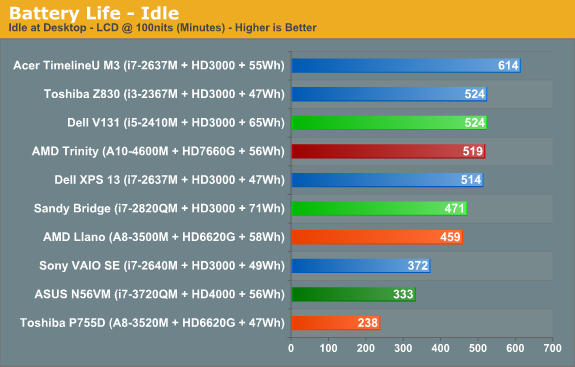
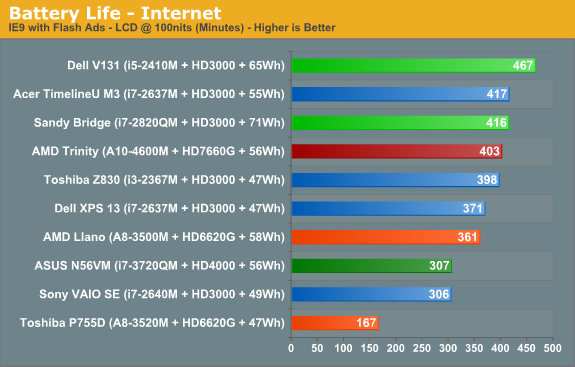
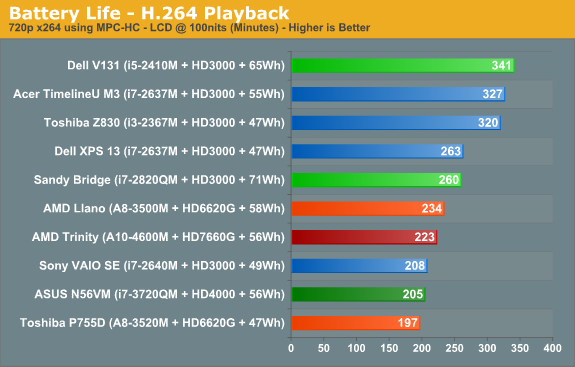
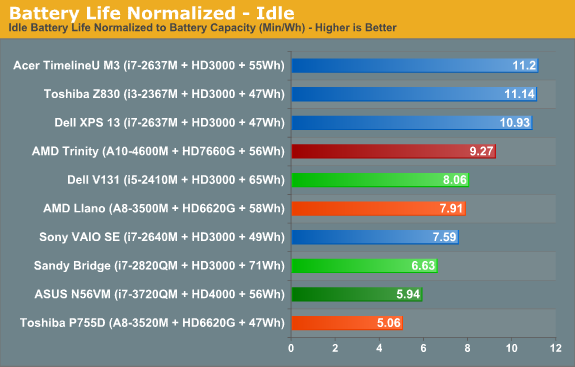

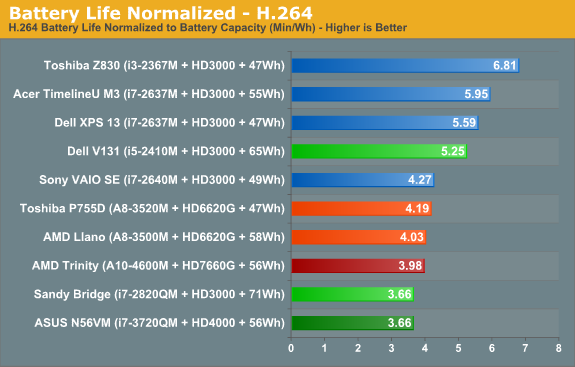
With a similar capacity battery to the original Llano laptop, and the same size 14” panel, Trinity comes out of the gates and posts two clear wins: idle battery life and Internet battery life are both up substantially relative to Llano. In fact, looking at the normalized charts, the only laptops that can consistently beat Trinity are found in Sandy Bridge ultrabooks—we won’t even bother discussing Atom or Brazos netbooks, as they’re competing in a completely different performance bracket. In something of a surprise, H.264 battery life doesn’t see the same benefit unfortunately, and it’s the one discipline where Llano still holds on to a slight lead over Trinity. Sandy Bridge meanwhile has always done very well in H.264 battery tests, and we see that with the Vostro V131 posting a normalized score that’s 30% better than Trinity and Llano. Of course, on the other end of the spectrum we have Ivy Bridge; we’ve only looked at one Ivy Bridge laptop so far, but if the pattern holds than Ivy Bridge will generally be a moderate step back in battery life relative to Sandy Bridge, giving AMD an even larger lead in this area.
We also performed a few other tests that we won’t present in graph form. One set of tests we alluded to earlier: the charts show Trinity with a Samsung 830 SSD, but we also ran tests with an Intel 520 SSD. Idle battery life dropped to 476 minutes (an 8% decrease), Internet battery life checked in at 371 minutes (down 8% again), and H.264 battery life stayed nearly the same at 217 minutes (down less than 3%). If battery life is one of your primary concerns, remember: all SSDs are not created equal!
Another test that we ran is simulated gaming; we looped the four graphics tests in 3DMark06 at 1366x768 until the battery ran out. We’ve run this same test on quite a few other laptops, and Llano initially looked to be far and away the best solution. Later, we discovered that when we tested Llano we were letting the GPU run in power saving mode—basically half the performance you’d get compared to being plugged in. We retested and measured 98 minutes, so the extra graphics performance comes with a heavy cost. We only tested Trinity (and Ivy Bridge and Sandy Bridge) using higher performance graphics settings, and this is one more area where it scores worse than Llano: Trinity managed just 77 minutes. That’s about the same as Ivy Bridge and Sandy Bridge (79 and 73 minutes, respectively), so if you’re after better gaming performance while running off the mains, you might need to keep looking.
Before getting too carried away with the above results, you still need to consider how important battery life is for your usage model. Some people travel a lot and like to go all day without plugging in; others will go from place to place and plug in whenever they’re not on the go. If you fall in the latter category, battery life isn’t usually a problem with any decent laptop, while those looking for all-day computing will definitely want as much mobility as possible. Ultimately, battery life is a factor of battery capacity as well as power optimizations done by the OEMs. We’ve seen battery life improve by as much as 50% when comparing two otherwise similar notebooks, but at least AMD’s reference platform for Trinity delivers a great starting point.
Temperatures and Acoustics
One other item we wanted to quickly touch on is system temperatures. We typically use HWMonitor and check temperatures of laptops under idle and load conditions. We did this with Trinity as well, but unfortunately the current version of HWMonitor doesn’t give us a lot of information. The only temperatures it reports are from the SSD and the HD 7660G graphics—there’s nothing about CPU core temperatures. That means we can’t provide much detail, other than to say that load temperature on the GPU topped out at 71C during extended testing, while the idle temperature was 39C. As usual, temperatures and noise levels go hand in hand, and the low 71C maximum GPU temperature matches up nicely with noise levels that never got above 37dB. It’s not the quietest laptop we’ve ever tested, and surface temperatures can get a little warm, but overall Trinity looks to be a good balance of performance and power requirements, which means quiet laptops are definitely possible.










271 Comments
View All Comments
CeriseCogburn - Thursday, May 24, 2012 - link
The average home user needs adobe reader guy. They won't get by without it - the home user always has some adobe pdf they have to be able to open. So that's the whole base.You have failed.
Spunjji - Wednesday, May 16, 2012 - link
You have quite massively misinterpreted the type of person I am. I would not have a laptop running an SB i7 if all I wanted was "good enough" and I hate management who ignore the genuine requirements of their users.The point I am making is that Trinity does *not* perform like a 6 year old CPU. It is about 2 years behind Intel, granted, but most users I have encountered are 2 years back from that in their requirements. There are edge cases and you appear to be one. Good for you. I do not wish for this to be a pissing match, I do not know 100 million business users, I have just spent a long time mediating between ordinary people and I.T. and I do it for a living.
I will be recommending Trinity to people looking for a new laptop that is good for multi-use roles, won't break the bank, and oh yes is *new*. 6 year old processors are irrelevant when you're buying a new machine, in case you hadn't noticed, and people don't just replace laptops because they want something *faster*. Your inability or unwillingness to realise this puts you at a significant distance from the majority of buyers.
CeriseCogburn - Thursday, May 24, 2012 - link
No, core 2 duos are all over the place still brand new, so maybe your customers are getting really screwed.yyrkoon - Tuesday, May 15, 2012 - link
"It's like buying a laptop from 2004, with a DX11 upgrade."Not even close. I actually own a Liano system. An A6-3400m system that in reality only operates at 1400Mhz. Despite the marketing hype that it has turbo boost to 2300Mhz. Once the CPU heats up a little, 1400Mhz is all you get. The lack of responsiveness you mention is all in your head.
Besides, when / if there were application loading slow downs, I would have to question the application its self, the storage medium which I am using, or the fact that my own system is currently only running single channel memory - First.
Even if there were some noticeable performance hit. It is not as if I had A. D. D, and could not stand to sit another 5-10 seconds.
Key word. "Priorities". We all have them. College tuition vs a laptop that will play ( next latest greatest game ) *really fast*. You have your priorities. You make the call. For your own self.
potatochobit - Tuesday, May 15, 2012 - link
you are doing it wrong.if you need more than 1500mhz you need to turn on AMD overdrive.
it is not a problem with the computer, it means your bios is probably locked by the manufacturer. you might also try googling about k10stats.
yyrkoon - Tuesday, May 15, 2012 - link
Never said anything about needing more than 1400Mhz,. I said the responsiveness "issue" was all in the original posters mind. The point I was eluding to was that the A10 should be perfectly fine with a clock speed of 2300Mhz. Even better if it can be clocked higher while remaining in a decent temperature range. Which I am thinking it should.And yeah, K10STATs works just fine, for running the clock up to 2300Mhz. *If* I did not care about the laptop CPU temps running at 89C, and above. Which I would add, is the wrong way.
@rarson
I can retype it just for you, if my point was not clear. Sorry, the A6-3400M part must have thrown you. EL EL A EN OH - Better ? Or still too confusing for you ?
Seriously? Is that the best you've got ?
Roland00Address - Tuesday, May 15, 2012 - link
but can we have a follow up with how mobile trinity and ivy bridge handle diablo 3 since many laptop purchasers will be purchasing laptops with the express purpose of playing that game.A5 - Tuesday, May 15, 2012 - link
I can't imagine it'll be too different from Starcraft 2.dwade123 - Tuesday, May 15, 2012 - link
Meh. Just grab an Intel and at least a GT 640m. That's what most people would do.kshong - Tuesday, May 15, 2012 - link
The major problem that I will have with trinity is price. If Jarred's price estimate is correct (600-700 dollars), I think I will have to buy an ivy bridge cpu + nvidia geforce gt 640 computer.I wish AMD would sell an A-10 powered laptop for 450-550 dollars. Now that is a price that I am willing to pay for. Otherwise, I think I will pay a bit more to get something else.